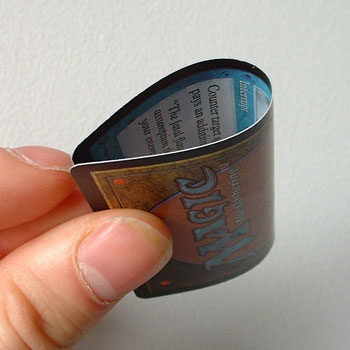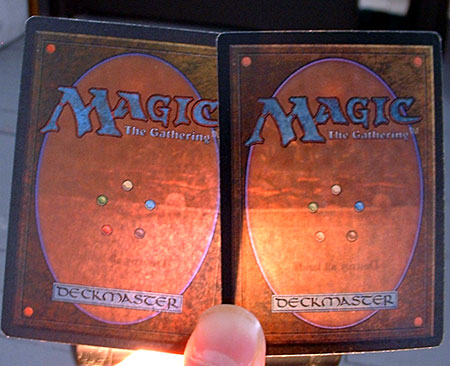3.3 Various ways to test your card
- If you still think your card looks odd, there are a bunch of simple tests you can use to help determine if it's fake or not. These tests are meant only for regular edition cards! If you are concerned about foil cards, please read the section later on about testing foil cards. I have done my best to show you how to properly perform these tests, but it's always best to have somebody who has done them before to show you in person. There's always a chance you might ruin an otherwise perfectly good card. Always use caution when doing these tests, and if you want to test a really valuable card, ask a professional.
3.3.1 Comparison
- If at all possible, compare the suspicious card with one you know is real. Sometimes just holding the fake one next to a real one will cause many printing differences to become obvious. If you have a large number of cards that you think may be fake, take a stack of the same number of cards and see if they are the same height. All Magic cards are approximately 0.012 inches (0.305 mm) thick. Stacking is a good way to spot rebacked cards. Foil cards are slightly thicker than regular cards. Individually this is almost unnoticeable, but when comparing stacks, 20 foils cards is about equivalent to 23 regular Magic cards.
3.3.2 The Bend Test
One of the oldest and most widely used tests is the bend test. All real Magic cards, when bent end-to-end, will not crease. Many fake cards will crease or completely split when this is done. A real card can handle at least ten or so bend tests before it too will give in. Always be careful when bending a card. Press only the edges of the card together. If you press on the middle you risk creasing the card. If you bend a card too many times you also risk creasing the card. There is no way to know how many times a card has been bent, but someone with experience can usually tell if a card has been bent in the past or not by feeling it. 
3.3.3 The Light Test
Hold a real card up to a lightbulb. If it is bright enough (like halogen bright) you can start to see through it. All Magic cards are like this. Some fake cards are not. And some fake cards are too transparent. Compare a real one to the one you think is fake. This is also good for spotting a card front that has been pasted on with a real card still underneath. To the right is an image of two cards. The one on the left is real, the one on the right is fake. The paper used in printing the fake has a much smoother internal texture. This would not have been exposed without a halogen lamp. 